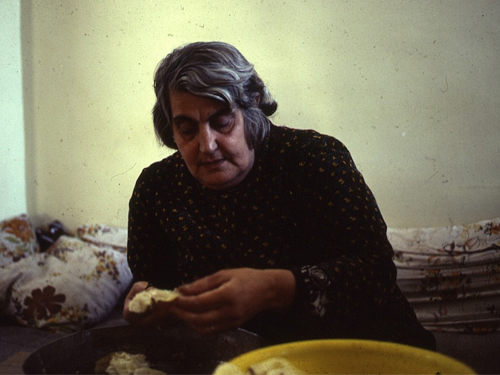On 18 March 2021, Sabzian and Courtisane are hosting the seventh Milestones screening online, presenting Al Dhakira al Khasba [Fertile Memory] (Michel Khleifi, 1980), the first full length film to be shot within the disputed Palestinian West Bank “Green Line”. Fertile Memory is the feature debut of Michel Khleifi, acclaimed director of the Cannes Film Festival triumph, Wedding in Galilee. Lyrically blending both documentary and narrative elements, Khleifi skillfully and lovingly crafts a portrait of two Palestinian women whose individual struggles both define and transcend the politics that have torn apart their homes and their lives.
On the occasion of the online screening of Fertile Memory, Sabzian will be publishing several texts on the film on 17 March 2021. On the evening of the screening, an introduction to the film by Stoffel Debuysere will be posted on Sabzian. The film will be available on Sabzian, free of charge, worldwide.
The presentation of Fertile Memory is part of a series of four Milestones screenings hosted online by Sabzian, of which three are in collaboration with Courtisane. The film and introduction will be available on Sabzian’s home page on the day itself.
Michel Khleifi (1950) was born in Israel to an Arab-Palestinian family. He worked as a car mechanic before leaving Israel in 1970, at the age of 20, with the intention of working for Volkswagen in Germany. Along the way, Khleifi visited a cousin in Belgium, where he ultimately stayed and has lived ever since. Khleifi studied theatre directing, radio and television at the INSAS in Brussels where he graduated in 1977. After making a series of television reports, he returned to his native region for the first time in 1980 to produce the author’s documentary Al Dhakira al Khasba [Fertile Memory]. Fertile Memory is the first feature film to be shot in the controversial Palestinian West Bank. In 1987, Khleifi made his fiction debut Urs al-Jalil [Wedding in Galilee], a political film deeply rooted in the Israeli-Palestinian conflict, shot just before the Intifada and with which he gained international renown. Wedding in Galilee was the first Palestinian film ever selected for the Cannes Film Festival where it won the Prix de la critique international. The Royal Belgian Film Archive, the current CINEMATEK, restored several of his films, including Ma'loul fête sa destruction [Ma'loul Celebrates Its Destruction] (1985), Wedding in Galilee (1987), Nashid al-Hajjar [Canticle of the Stones] (1990), and Hikayatul jawahiri thalath [Tale of the Three Lost Jewels] (1994). By showing the complexity of life under occupation in all its contradictions, Khleifis films marked a major shift in the history of Palestinian cinema. Rather than conforming to images of internal homogeneity and external dualism, his films continued to re-envision Palestine/Israel as a polyphonous multiplicity of trajectories set out by individuals who manage to lift their thoughts and efforts to meet the challenges imposed on them. As the fundamental figure of Palestinian cinema, Khleifi’s formal innovations, a cinema that offers an unforced unity of documentary and fictive forms, and his labyrinthine approach to Palestinian collective memory, continue to resonate.
![Al Dhakira al Khasba [Fertile Memory] (Michel Khleifi, 1981) Al Dhakira al Khasba [Fertile Memory] (Michel Khleifi, 1981)](/sites/default/files/ADH-DHAKIRA%20AL%20KHISBA%20%28Khleifi%29_4%20kopie_0.jpg)
Milestones is a series of stand-alone screenings, hosted by Sabzian, of film-history milestones, reference works or landmarks, films that focus on aesthetic or political issues and stimulate debate and reflection. In earlier instalments, Sabzian presented Andy Warhol’s Sleep (1964), Jean-Luc Godard’s monumental video work Histoire(s) du cinéma (1988-1998), Robert Kramer’s Milestones (1974), Méditerranée (1963) and L’ordre (1973), two films by Jean-Daniel Pollet and recently Shadi Abdel Salam’s Al-mummia (1969) and Georges Rouquier’s Farrebique ou les quatres saisons (1946). For each screening, Sabzian publishes texts that contextualize the film.
With the support of the Flemish government



